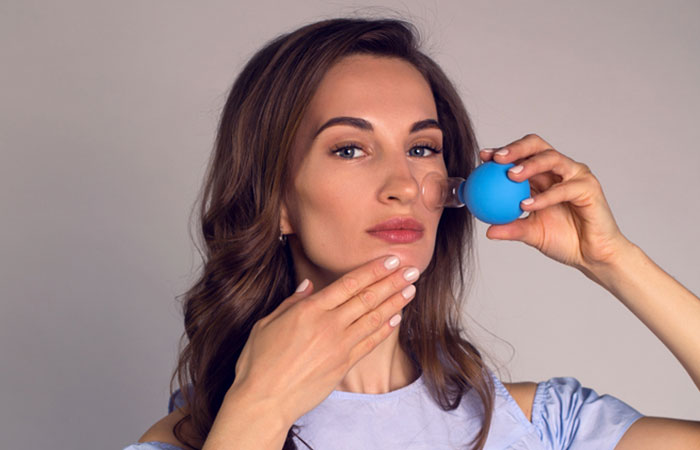Everything About Facial Cupping

Cupping is an alternative therapy that uses suction cups to stimulate your skin and muscles. It can be done on your face or body.
The suction promotes increased blood circulation, which may help relieve muscle tension, promote cell repair, and aid in other regeneration.
It’s also said to improve the flow of your “qi” (pronounced “chee”). Qi is a Chinese word meaning life force.
Although the practice is deeply ingrained in Traditional Chinese Medicine, some researchers sayTrusted Source that the earliest pictorial records originated in ancient Egypt.
Is facial cupping the same as body cupping?
Yes and no. Although they’re based on the same principle of restoration, facial and body cupping are executed differently.
Facial cups are typically smaller and softer. They’re used to gently pull the skin away from deeper layers of fascia. This increases blood flow to the area and rejuvenates the skin without leaving cup marks behind.
“Over time this practice improves the complexion and diminishes fine lines and wrinkles,” says Ananda Emily Reese, LAc, of Reese Acupuncture.
Body cupping, on the other hand, is primarily used to alleviate aches and pains.
Cup marks are almost always left behind, but they do serve a diagnostic purpose; the size, shape, and color are said to reflect the amount of “stagnation” or cellular waste buildup. These marks fade as your lymphatic system processes the waste.
How does it work?
The suction effect pulls blood into the area of skin underneath the cup. This saturates the surrounding tissue with fresh blood and promotes new blood vessel formation.
Cupping also promotes sterile inflammation. Sterile inflammation is a form of pathogen-free trauma. With cupping, it results from mechanical trauma.
The vacuum-like suction separates different layers of tissues, resulting in microtrauma and tearing. This triggers an inflammatory response, flooding the area with white blood cells, platelets, and other healing aids.
What are the benefits?
Facial cupping has been shown to:
- increase oxygen-rich blood circulation
- strengthen skin and connective tissues
- stimulate cells responsible for collagen production
- relax muscle tension
Because of this, the practice is said to:
- brighten skin
- minimize the appearance of scars, fine lines, and wrinkles
- tone chin, jawline, neck, and décolletage
- decrease puffiness
- regulate oil production
- improve nutrient delivery and product absorption
Will it leave bruises?
Facial cupping shouldn’t leave bruises. However, bruising can occur if the cup is left in the same place for too long. Reese says that discoloration can occur in as little as five seconds, so make sure you keep the cup moving.
Are there any other side effects or risks?
Although facial cupping is generally considered safe, minor side effects are possible. They typically occur during or immediately after the treatment.
You may experience temporary:
- dizziness
- lightheadedness
- nausea
- cold sweats
Can you use facial cups at home?
At-home cupping kits exist, but you may find it easier to relax under the care of a professional. This may allow for a more even application.
Seeing a professional also ensures that the proper technique is followed.
If you decide you want try cupping at home, ask your practitioner for guidance. They can answer any questions you may have and may be able to recommend a reputable at-home kit.
A word of caution: You may develop unwanted bruising while you refine your technique. It may also take longer to achieve your desired results.
How do I get started?
There are a variety of different cupping kits you can use. Some cups are made from hard plastics, while others are soft and gel-like. Both can be equally effective, so it’s ultimately up to your personal preference.
You should always follow the directions on your cupping kit.
General guidelines suggest these steps:
- Wash your face and gently pat dry.
- Lightly massage your face with your hands to release preliminary tension.
- Although face oils are optional, applying a light layer to your skin may help decrease your risk of bruising as you move the cups.
- Start by applying a small cup to your chin and around your mouth. Leave the cup in place for few seconds and then move upward to a new area.
- Swap smaller cups for larger cups as needed, like when you get to your forehead.
- Continue until you have successfully cupped all desired areas.
- If you used a face oil, cleanse your face and pat dry. Otherwise, use a splash of warm water to reopen your pores.
- Continue with your beauty or skin care routine. Facial cupping is said to increase product absorption, so now’s the time to apply.
- You may notice minor redness and irritation afterward. This is normal and should subside within a few hours.
The bottom line
Facial cupping promotes circulation, which may help minimize the appearance of fine lines and wrinkles, decrease puffiness, and more.
You can experiment with facial cupping at home, but it may be best to reach out to an experienced practitioner for your first session. They can answer any questions you have and may be able to offer additional guidance on your skincare needs.

